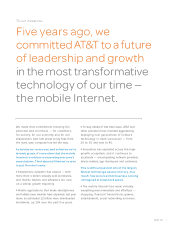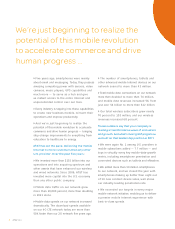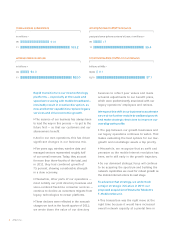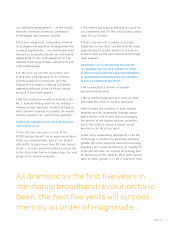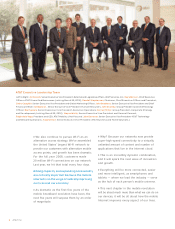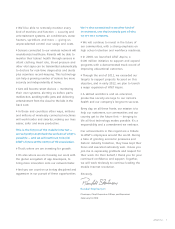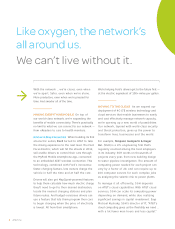AT&T Wireless 2011 Annual Report Download - page 6
Download and view the complete annual report
Please find page 6 of the 2011 AT&T Wireless annual report below. You can navigate through the pages in the report by either clicking on the pages listed below, or by using the keyword search tool below to find specific information within the annual report.
4 AT&T Inc.
Rapid transitions to our new technology
platforms — especially at the scale and
speed we’re seeing with mobile broadband —
inevitably result in creative disruption, as
new and better capabilities replace legacy
services and drive economic growth.
The essence of our business has always been
to lead the way in this process — to get to the
future first — so that our customers and our
shareowners benefit.
And in our own operations, this has driven
significant changes in our business mix.
Five years ago, wireless, wireline data and
managed services represented roughly half
of our overall revenues. Today, they account
for more than three-fourths of the total, and
in 2011 they had combined growth of
7.5 percent, showing considerable strength
in a slow economy.
Meanwhile, other parts of our operations —
most notably our print directory business and
voice-centered fixed-line consumer services —
continue to decline as customers migrate from
legacy technologies to newer platforms.
These declines were reflected in the noncash
charges we took in the fourth quarter of 2011;
we wrote down the value of our directory
business to reflect peer values and made
actuarial adjustments to our benefit plans,
which were predominantly associated with our
legacy operations’ employees and retirees.
We expect this shift in our business to accelerate
as we drive further mobile broadband growth
and make strategic decisions to improve our
overall growth profile.
The gap between our growth businesses and
our legacy operations continues to widen. That
makes evaluating the best options for our low-
growth and nonstrategic assets a top priority.
Meanwhile, we recognize that as swift and
pervasive as the mobile Internet revolution has
been, we’re still early in the growth trajectory.
So our dominant strategic focus will continue
to be acquiring the spectrum and building the
network capabilities we need for robust growth as
the mobile Internet enters its next stage.
To advance that strategy, we undertook
a major strategic initiative in 2011: our
proposed acquisition of Deutsche Telekom’s
T-Mobile USA unit.
This transaction was the right move at the
right time because it would have increased
overall network capacity at a pivotal time in
total wireless subscribers
in millions >
smartphones on AT&T’s network
postpaid smartphones at end of year, in millions >
06 06
11 11
103.2 39.4
<761.0
wireless data revenues
in billions >
06 12/06
11 12/1 1
total mobile data traffic on our network
billions of MBs >
$22.0 27.1
$4.3 0.1



